Arizona Wild Flowers
Pictures, Photos, Images
Descriptions, Information, Reviews.
Saguaro Cactus, Carnegiea gigantea.
We Are Proud Of Our SafeSurf Rating!
Click On Any Of The Following Links By Amazon.Com
For Books, & Videos About Wildflowers Of Arizona & The Southwest USA. No Obligation!
 |
| Saguaro Cactus, Cereus giganteus or Carnegiea gigantea. Photo Of Arizona State Flower And Italian Honey Bee, Apis mellifera ligustica. |
|---|
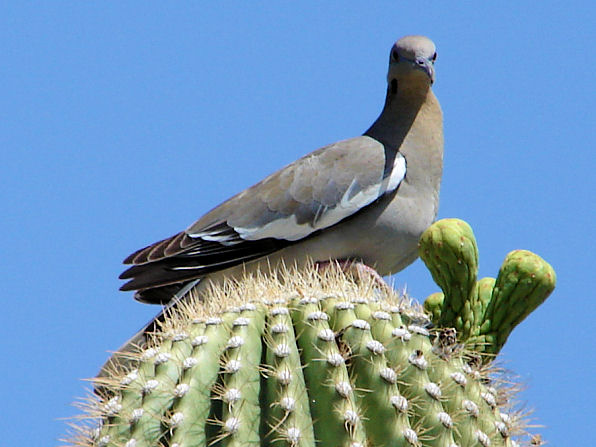 |
| Saguaro Cactus, Cereus giganteus, Carnegiea gigantea And White - Winged Dove, Zenaida asiatica. |
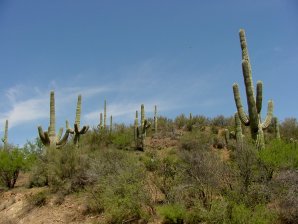 | 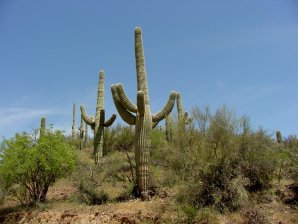 |
| Saguaro Cactus Carnegiea gigantea (Cereus giganteus) They Cover Whole Hillsides! | "Sentinals Of The Desert" Reach The Age Of 200 - 300 Years Old! |
|---|---|
 | 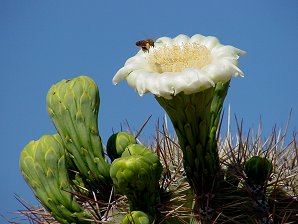 |
| Saguaro Cactus Carnegiea gigantea (Cereus giganteus) Juvenile Plant Shown This Plant Perhaps 40 Years Old | Creamy-White, 3 " Wide Flowers With Yellow Centers Bloom May And June Lesser Long-Nosed Bat Migration Timed To Their Flower Opening |
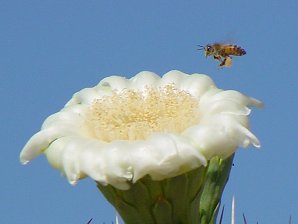 | 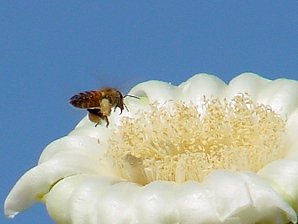 |
| Honey Bees Love Saguaro Flowers | There are over 1000 Species Of Bees In The Sonoran Desert |
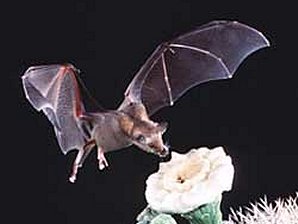 | 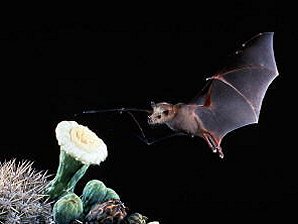 |
| Lesser Long-Nosed Bats Leptonycteris curasoae yerbabuenae | Are Very Important Pollinators Of The Saguaro Cactus |
 | 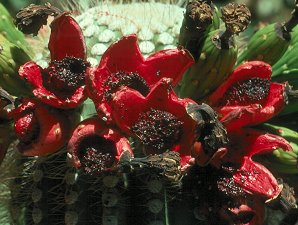 |
| Fruit Bright-Red, Pulpy Flesh | Ripe Saguaro Fruit |
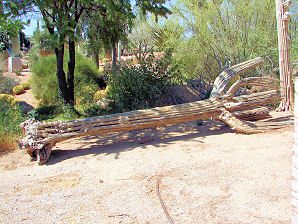 | 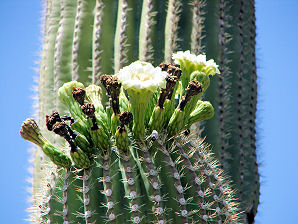 |
| Saguaro Cactus Skelton | Saguaro Cactus, Cereus giganteus or Carnegiea gigantea |
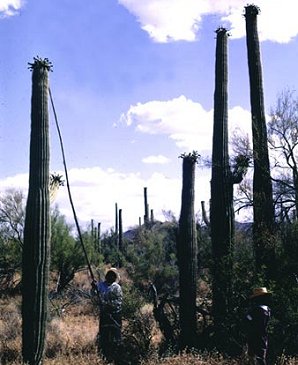 | 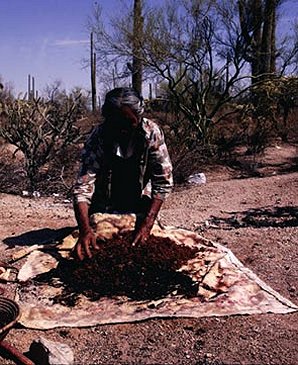 |
| Tohono O'odham Men Demonstrating Removal Of Saguaro Fruit | Generations Of Tohono O'odham Women Have Harvested The Bright-Red, Pulpy Flesh Fruit |
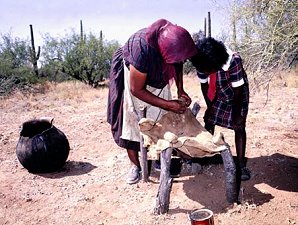 | 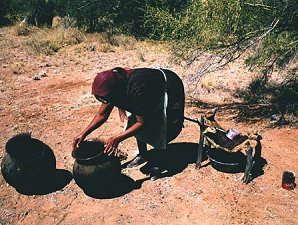 |
| Processing The Scarlet Colored Saguaro Fruit Pulp Into A Syrup Tasting Like Pomegranate. | The Syrup Then Fermented Into Nawait A Ceremonial Cactus Wine |
 /
/

Saguaro Cactus.
We wish to thank Wikipedia, the free encyclopedia for some of the information on this page. We share images and information with Wikipedia. The saguaro scientific name Carnegiea gigantea) is a large, tree-sized cactus species in the monotypic genus Carnegiea, which can grow to be over 70 feet tall. It is native to the Sonoran Desert in the U.S. state of Arizona, the Mexican state of Sonora, and the Whipple Mountains and Imperial County areas of California. The saguaro blossom is the State Wildflower of Arizona. The saguaro cactus is a dominant plant form of the Sonoran Desert. A young saguaro takes nearly a decade to reach one inch tall, it can reach heights of about fifty feet, which makes it the largest cactus in the United States. The saguaro is a single-stemmed, columnar cactus supported by woody ribs. The skin of the cactus is light green and waxy. Spines are clustered down the length of the ridges. At seventy-five years old, the cactus begins to sprout arms that grow parallel to the body. As many as fifty arms have been found on older saguaros estimated to be 200 - 300 years old. A Saguaro cactus can weigh over nine tons. Saguaro flowers are pollinated by nectar feeding bats, birds and insects. While a single fruit of a saguaro can produce over 2000 jet - black seeds; only a few of the seeds that a saguaro produces in its lifetime, will germinate and grow to maturity. While many animals, birds, and insects enjoy the fruit of the saguaro, there are many of these creatures which also make their homes in the Saguaro. The most widely known of the birds are the Gila Woodpecker, which creates many of the nest holes seen in mature saguaro stems. Each year the woodpecker creates a new nest hole, and the previous one is then occupied by insects, lizards or occasionally by the Elf Owl. The gilded flicker also produces nest holes in saguaros. Occasionally, the major branches of saguaros can have large twig-nests of hawks such as the red-tailed hawk or the Harris hawk. At Alamo Lake, Arizona there are Bald Eagles which nest on the top branches of the Saguaro. Saguaro are located almost all over the state of Arizona mainly in the Sonora Desert. There are no Saguaro in the high deserts of northern Arizona. While there are three National Parks dedicated to the protection of the Saguaro, there are many other locations in Arizona with far better displays of Saguaros, than what are in the National Parks. One area is located at Lake Pleasant, Arizona. While most Saguaro cacti grow in the typical fashion, a few individuals will grow in an atypical form known as a cristate or crested saguaro. These bizarre looking forms often grow as a crest
Quick Notes:
Height: Up To About 15 feet - 50 feet tall. Some have been found reaching 70 feet.
Flowers: Creamy-white, About 3-inch-wide flowers with yellow centers bloom during May and June. Clustered near the ends of branches, the blossoms open during cooler desert evenings and close again by the next midday.
Flowering Time: May - June.
Stem: From about 1 foot - 3 feet in diameter consisting of an interior framework of about 12 - 30 or more woody ribs supports the spongy tissue. The waxy, fluted surface allows the cactus to expand like an accordion during the rainy seasons and shrink back down during the dry.
The shallow roots spread out to over 40' and can absorb up to 200 gallons of water a week during the rainy season. In about one out of 200,000 saguaros, the top mutates to form a crest called a cristate.
Fruit: The fruit is up to 1 3/4 inches by 3 inches, with an egg shape, the green fruit ripens over about a 45 day period of time and turns a dark red color then just before the fall rainy season, it splits open to reveal bright-red, pulpy flesh which many of the desert creatures seem to enjoy. This ripening time would be about the last half of June into Mid - July. In the Phoenix Area, we find the ripening time is usually at about July 7th. This fruit was a food source to the Native Americans of Arizona who used the flesh, seeds and juice.
Leaves: Cactus thorns are modified leaves. Their shape conserves water and adds protection to the cactus plant.
Found: Native to the Sonoran Desert in the U.S. state of Arizona, the Mexican state of Sonora, and the Whipple Mountains and Imperial County areas of California.
Hardiness:
Soil pH requirements:
Sun Exposure:
Elevation: 0 - 3,600 Feet. But, we have seen some at 4,228 feet.
Habitat: Desert slopes and flats, rocky bajadas. The saguaro begins life under a "nurse" plant, typically a palo-verde or mesquite tree. The "nurse" tree provides shade and increased water availability during the summer, and protects it from winter frosts.
Miscellaneous: Flowering Photos Taken May 11, 2003; near the I-17 and Carefree Highway, in Arizona.
|



We Are Proud Of Our SafeSurf Rating!
Click On Any Of The Following Links By Amazon.Com
For Books, & Videos About Xerioscape Plants Of Arizona & The Southwest USA. No Obligation!
Back To Arizona Wild Flowers Home Page.
Back To Arizona Wild Flowers, Cream - White Flowers Page One.
Back To Arizona Xeriscape Landscaping Main Page.
Back To Xeriscape Cactus Page One.
Back To DeLange Home Page
© 1966 - Present, Audrey, Eve, & George DeLange
| © 1966 - Present, Audrey, Eve, & George DeLange |


